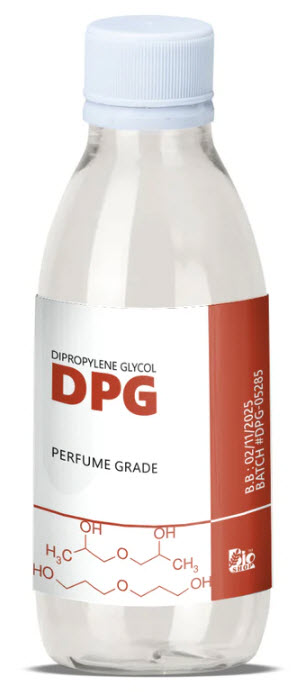Dipropylene Glycol (DPG) is a synthetic organic compound widely used in perfumery, cosmetics, and other industries. Unlike traditional aroma chemicals, DPG is not used for its scent but rather as a solvent, carrier, and diluent for fragrance oils and other ingredients. Below is a detailed explanation of DPG, including its properties, uses, and significance in perfumery.

1. Chemical Structure and Properties
- Chemical Name: Dipropylene Glycol
- IUPAC Name: 2,2′-Oxybis(propan-1-ol) or 1,1′-Oxybis(propan-2-ol)
- Molecular Formula: C₆H₁₄O₃
- Molecular Weight: 134.17 g/mol
- Appearance: A colorless, slightly viscous liquid.
- Odor: Odorless or very faint, sweet odor.
- Solubility: Miscible with water, alcohol, and many organic solvents, making it highly versatile.
- Boiling Point: Approximately 230°C (446°F).
- Stability: Stable under normal conditions, non-reactive, and resistant to oxidation.
2. Role in Perfumery
DPG is not an aroma chemical but plays a critical role in the formulation of perfumes and fragrances. Its primary functions include:
- Solvent: It dissolves and dilutes fragrance oils, essential oils, and other aromatic compounds, ensuring they blend smoothly into the final product.
- Carrier: It helps distribute fragrance ingredients evenly throughout a formulation, enhancing consistency and performance.
- Stabilizer: It stabilizes volatile compounds, preventing them from evaporating too quickly and improving the longevity of the fragrance.
- Diluent: It reduces the concentration of potent fragrance oils, making them safer and easier to work with.
3. Why is DPG Used in Perfumery?
DPG is favored in perfumery for several reasons:
- Odorless Nature: It does not interfere with the scent profile of the fragrance, allowing the aroma chemicals to shine.
- Versatility: It is compatible with a wide range of fragrance ingredients, including both natural and synthetic compounds.
- Safety: It is considered safe for use in cosmetics and fragrances when used within recommended concentrations.
- Cost-Effectiveness: It is an affordable and efficient solvent, making it a practical choice for large-scale production.
4. Common Uses in Perfumery
DPG is used in various applications within the fragrance industry:
- Perfume Formulations: It is used to dilute and stabilize concentrated fragrance oils, ensuring they are safe and easy to apply.
- Functional Fragrances: It is widely used in soaps, detergents, and household cleaners to carry and stabilize fragrance oils.
- Cosmetics: It is used in lotions, creams, and other personal care products to deliver fragrance and improve texture.
- Aromatherapy: It is used as a carrier for essential oils in diffusers and other aromatherapy products.
5. Safety and Regulation
DPG is generally considered safe for use in cosmetics and fragrances when used within recommended concentrations. Key points include:
- IFRA Compliance: The International Fragrance Association (IFRA) sets guidelines for the use of DPG in different product types to ensure safety.
- Non-Toxicity: It is non-toxic and non-irritating when used in appropriate amounts.
- Patch Testing: While generally safe, it is always recommended to conduct patch tests to ensure it does not cause adverse reactions in sensitive individuals.
6. Advantages in Perfumery
- Odor Neutrality: Its odorless nature ensures it does not alter the intended scent profile of a fragrance.
- Versatility: It is compatible with a wide range of fragrance materials, making it a versatile tool for perfumers.
- Stability: It helps stabilize volatile compounds, improving the shelf life and performance of fragrances.
- Cost-Effectiveness: It is an affordable and efficient solvent, making it a practical choice for large-scale production.
7. Limitations
- Not a Fragrance Ingredient: DPG does not contribute to the scent of a perfume, so it is not used for its aromatic properties.
- Overuse: Excessive use of DPG can dilute a fragrance too much, reducing its intensity and longevity.
- Regulatory Restrictions: Compliance with IFRA and EU regulations may restrict its use in certain formulations.
8. Example Products Featuring DPG
DPG is found in numerous products, including:
- Perfumes and Colognes: Used as a solvent and carrier for fragrance oils.
- Soaps and Detergents: Helps stabilize and distribute fragrance in cleaning products.
- Lotions and Creams: Used to deliver fragrance and improve texture in personal care products.
- Aromatherapy Oils: Acts as a carrier for essential oils in diffusers and other aromatherapy products.
9. Conclusion
DPG (Dipropylene Glycol) is a fundamental ingredient in perfumery, prized for its role as a solvent, carrier, and stabilizer. While it does not contribute to the scent of a fragrance, its ability to dissolve, dilute, and stabilize aromatic compounds makes it indispensable in creating consistent, safe, and high-performing perfumes. Its odorless nature, versatility, and cost-effectiveness ensure its continued prominence in the fragrance industry. However, its use must be carefully regulated to avoid over-dilution and ensure compliance with safety guidelines.